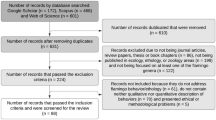Abstract
Cooperative behavior has been observed in cetacean species in a variety of situations, including foraging, mate acquisition, play, and epimeletic behavior. However, it has proven difficult to demonstrate cooperative behavior among dolphins in more controlled settings. Dolphins (Tursiops truncatus) in this study were exposed to a task that could most easily be solved if dolphins cooperated. Six dolphins were provided opportunities to solve the task and had to learn to do so without human intervention or training. Two adult males consistently and spontaneously jointly interacted in order to most efficiently open a container that contained fish by pulling on ropes at the ends of the container. Their interaction was viewed as cooperative because each dolphin pulled on their respective ropes in the opposite direction, which resulted in one end of the container opening. The dolphins did not show aggression toward one another while solving the task, and both dolphins consumed the food after the container was opened. They also engaged in synchronous non-aggressive behaviors with the container after the food had been consumed. It is possible that some of the remaining four dolphins would have cooperated, but the two successful dolphins were dominant males and their interest in the apparatus appeared to preclude other animals from participating.



Similar content being viewed by others
References
Altmann J (1974) Observational study of behavior: sampling methods. Behaviour 49(3/4):227–267
Benoit-Bird KJ, Au WWL (2009) Cooperative prey herding by the pelagic dolphin, Stenella longirostris. J Acous Soc Am 125(1):125–137. doi:10.1121/1.2967480
Boesch C, Boesch H (1989) Hunting behavior of wild chimpanzees in the Taï National Park. Am J Phys Anth 78:547–573
Caldwell MC, Caldwell DK (1966) Epimeletic (care-giving) behavior in Cetacea. In: Norris KS (ed) Whales, dolphins and porpoises. University of California Press, Los Angeles, pp 755–789
Chalmeau E (1994) Do chimpanzees cooperate in a learning task? Primates 35(3):385–392
Chalmeau R, Gallo A (1996) Cooperation in primates: critical analysis of behavioural criteria. Behav Process 35:101–111
Chalmeau R, Visalberghi E, Gallo A (1997) Capuchin monkeys, Cebus apella, fail to understand a cooperative task. Anim Behav 54:1215–1225
Cockcroft VG, Sauer W (1990) Observed and inferred epimeletic (nurturant) behavior in bottlenose dolphins. Aquat Mamm 16(1):31–32
Connor RC, Smolker RA, Richards AF (1992) Two levels of alliance formation among male bottlenose dolphins (Tursiops sp.). Proc Natl Acad Sci USA 89(3):987–990
Connor RC, Wells RS, Mann J, Read AJ (2000) The bottlenose dolphin: social relationships in a fission-fusion society. In: Mann J, Connor RC, Tyack PL, Whitehead H (eds) Cetacean societies: field studies of dolphins and whales. University of Chicago Press, Chicago, pp 91–126
Crawford MP (1937) The cooperative solving of problems by young chimpanzees. Comp Psy Monogr 14(2):1–88
Daura-Jorge FG, Cantor M, Ingram SN, Lusseau D, Simões-Lopes PC (2012) The structure of a bottlenose dolphin society is coupled to a unique foraging cooperation with artisanal fishermen. Biol Lett 8:702–705. doi:10.1098/rsbl.2012.0174
de Moura JF, Rodrigues EDS, Siciliano S (2009) Epimeletic behavior in rough-toothed dolphins (Steno bredanensis) on the east coast of Rio de Janeiro State, Brazil. Mar Biodivers Rec 2(12):1–3. doi:10.1017/S1755267208000122
Duffy-Echevarria EE, Connor RC, St. Aubin DJ (2008) Observations of strand-feeding behavior by bottlenose dolphins (Tursiops truncatus) in Bull Creek, South Carolina. Mar Mamm Sci 24(1):202–206. doi:10.1111/j.1748-7692.2007.00151.x
Hoese HD (1971) Dolphin feeding out of water in a salt marsh. J Mamm 52(1):222–223
Krützen M, Sherwin WB, Connor RC et al (2003) Contrasting relatedness patterns in bottlenose dolphin (Tursiops sp.) with different alliance strategies. Proc R Soc Lond B 270:497–502. doi:10.1098/rspb.2002.2229
Kuczaj SA, Eskelinen HC (2014) Why do dolphins play? Anim Behav Cogn 1(2):113–127
Kuczaj SA, Highfill LE (2005) Dolphin play: evidence for cooperation and culture? Behav Brain Sci 28(5):705–706
Kuczaj SA II, Walker RT (2012) Dolphin problem solving. In: Zentall T, Wasserman E (eds) Handbook of comparative cognition. Oxford University Press, New York, pp 736–756
Kuczaj SA, Yeater D (2007) Observations of rough-toothed dolphin (Steno bredanensis) off the coast of Utila, Honduras. J Mar Biol Assoc UK 87:141–148. doi:10.1017/S0025315407054999
Kuczaj SA, Lacinak CT, Fad O, Trone M, Solangi M, Ramos R (2002) Keeping environmental enrichment enriching. Int J Comp Psychol 15:127–137
Kuczaj SA, Gory JD, Xitco MJ (2009) How intelligent are dolphins? A partial answer based on their ability to plan their behavior when confronted with novel problems. Jpn J of Anim Psy 59(1):99–115. doi:10.2502/janip.59.1.9
Mann J, Smuts B (1999) Behavioral development in wild bottlenose dolphin newborns (Tursiops sp.). Behaviour 136:529–566
Mitani JC (2009) Cooperation and competition: current understanding and future challenges. Evolut Anthropol 18:215–227. doi:10.1002/evan.20229
Möller LM, Beheregaray LB, Harcourt RG, Krützen M (2001) Alliance membership and kinship in wild male bottlenose dolphins (Tursiops aduncus) of southeastern Australia. Proc Roy Soc B Biol Sci 268(1479):1941–1947. doi:10.1098/rspb.2001.1756
Park KJ, Sohn H, An YR, Moon DY, Choi SG, An DH (2013) An unusual case of care-giving behavior in wild long-beaked common dolphins (Delphinus capensis) in the East Sea. Mar Mamm Sci 29(4):1–7. doi:10.1111/mms.12012
Parsons KM, Durban JW, Claridge DE, Balcomb KC, Noble LR, Thompson PM (2003) Kinship as a basis for alliance formation between male bottlenose dolphins, Tursiops truncatus, in the Bahamas. Anim Behav 66:185–194. doi:10.1006/anbe.2003.2186
Paulos RD, Trone M, Kuczaj SA (2010) Play in wild and captive cetaceans. Int J Comp Psychol 23:201–722
Péron F, Rat-Fischer L, Lalot M, Nagle L, Bovet D (2011) Cooperative problem solving in African grey parrots (Psittacus erithacus). Anim Cogn 14:545–553. doi:10.1007/s10071-011-0389-2
Plotnik JM, Lair R, Suphachoksahakun W, de Waal FBM (2011) Elephants know when they need a helping trunk in a cooperative task. Proc Natl Acad Sci USA 108(12):5116–5121. doi:10.1073/pnas.1101765108
Ritter F (2007) Behavioral responses of rough-toothed dolphins to a dead newborn calf. Mar Mamm Sci 23(2):429–433. doi:10.1111/j.1748-7692.2007.00107.x
Seed AM, Clayton NS, Emery NJ (2008) Cooperative problem solving in rooks (Corvus frugilegus). Proc Roy Soc B Biol Sci 275(1641):1421–1429. doi:10.1098/rspb.2008.0111
Siebenaler JB, Caldwell DK (1956) Cooperation among adult dolphins. J Mamm 37(1):126–128
Silva-Jr JM, Silva FJL, Sazima I (2005) Rest, nurture, sex, release, and play: diurnal underwater behavior of the spinner dolphin at Fernando de Nornonha Archipelago, SW Atlantic. J Ichthyol Aquat Biol 9(4):161–176
Smith TG, Siniff DB, Reichle R, Stone S (1981) Coordinated behavior of killer whales, Orcinus orca, hunting a crabeater seal, Lobodon carcinophagus. Can J Zool 59(6):1185–1189
Smith BD, Tun MT, Chit AM, Win H, Moe T (2009) Catch composition and conservation management of a human–dolphin cooperative cast-net fishery in the Ayeyarwady river, Myanmar. Biol Conserv 142:1042–1049. doi:10.1016/j.biocon.2009.01.015
Tomasello M, Call J (1997) Primate cognition. Oxford University Press, Oxford
Torres G, Read AJ (2009) Where to catch a fish? The influence of foraging tactics on the ecology of bottlenose dolphins (Tursiops truncatus) in Florida Bay, Florida. Mar Mamm Sci 25(4):797–815. doi:10.1111/j.1748-7692.2009.00297.x
Vaughn RL, Muzi E, Richardson JL, Würsig B (2011) Dolphin bait-balling behaviors in relation to prey ball escape behaviors. Ethol 117:859–871. doi:10.1111/j.1439-0310.2011.01939.x
Visser IN, Smith TG, Bullock ID, Green GD, Carlsson OG, Imberti S (2008) Antarctic peninsula killer whales (Orcinus orca) hunt seals and a penguin on floating ice. Mar Mamm Sci 24(1):225–234. doi:10.1111/j.1748-7692.2007.00163.x
Warren-Smith AB, Dunn WL (2006) Epimeletic behavior toward a seriously injured juvenile bottlenose dolphin (Tursiops sp.) in Port Phillip, Victoria, Australia. Aquat Mamm 32(3):357–362. doi:10.1578/AM.32.3.2006.357
Watts DP, Mitani JC (2002) Hunting behavior of chimpanzees at Ngogo, Kibale National Park, Uganda. Int J Primatol 23(1):1–28
Würsig B (2002) Playful behavior. In: Perrin WF, Würsig B, Thewissen JGM (eds) Encyclopedia of marine mammals. Academic Press, San Diego, pp 943–945
Würsig B, Würsig M (1979) Behavior and ecology of the bottlenose dolphin (Tursiops truncatus), in the South Atlantic. Fish Bull 77(2):399–412
Würsig B, Würsig M (1980) Behavior and ecology of the dusky dolphin, Lagenorhynchus obscurus, in the South Atlantic. Fish Bull 77(4):399–412
Zaeschmar JR, Dwyer SL, Stockin KA (2013) Rare observations of false killer whales (Pseudorca crassidens) cooperatively feeding with common bottlenose dolphins (Tursiops truncatus) in the Hauraki Gulf. New Zealand. Mar Mamm Sci 29(3):555–562. doi:10.1111/j.1748-7692.2012.00582.x
Author information
Authors and Affiliations
Corresponding author
Rights and permissions
About this article
Cite this article
Kuczaj, S.A., Winship, K.A. & Eskelinen, H.C. Can bottlenose dolphins (Tursiops truncatus) cooperate when solving a novel task?. Anim Cogn 18, 543–550 (2015). https://doi.org/10.1007/s10071-014-0822-4
Received:
Revised:
Accepted:
Published:
Issue Date:
DOI: https://doi.org/10.1007/s10071-014-0822-4




